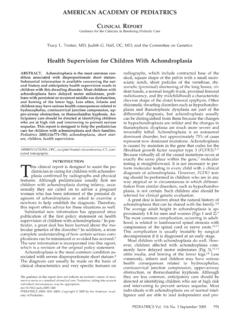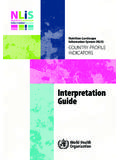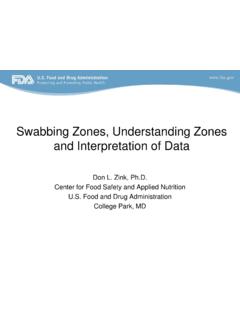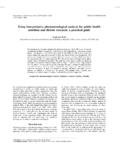Transcription of Age-appropriate body mass index in children with ...
1 Age-appropriate body mass index in children with achondroplasia: interpretation in relation to indexes of height1 3 Julie E Hoover-Fong, Kerry J Schulze, John McGready, Hillary Barnes, and Charles I ScottABSTRACTB ackground:Achondroplasia is the most common short statureskeletal dysplasia, with an estimated worldwide prevalence of250 000. Body mass index (BMI) for-age references are requiredfor weight management guidance for children with achondroplasia,whose body proportions are unlike those of the average stature :This study used weight and height data in a clinicalsetting to derive smoothed BMI-for-age percentile curves for chil-dren with achondroplasia and explored the relation of BMI with itscomponents, weight and :This was a longitudinal observational study of anthropo-metric measures of children with achondroplasia from birth through16 y of :The analysis included 1807 BMI data points from 280children (155 boys, 125 girls) with achondroplasia.
2 As comparedwith the BMI of peers of average stature, the BMI in children withachondroplasiaishigheratbirth,lacksa steepincreaseininfancyanda later nadir between 1 and2yofage, and remains substantiallyhigher through 16 y of age in both sexes. Patterns of change in heightand weight in children with achondroplasia are unique in that thereis no overlap in the height distribution after 6 mo of age and no spikein height velocity during infancy or puberty the 2 periods of great-est linear growth in individuals of average :Sex- and age-specific BMI curves are available forchildren with achondroplasia (birth to 16 y of age) for health sur-veillance and future research to determine associations with healthoutcomes (eg, cardiovascular disease, diabetes, and indication forand outcome of surgery).
3 Am J Clin Nutr2008;88:364 is the most common short stature-skeletaldysplasia, occurring in 1 of 20 000 births (1 4). Sporadic mu-tations in fibroblast growth factor receptor 3 (FGFR3) cause 80%ofachondroplasiacases,with98%ofallcas esattributableto one mutation (G1138A). Clinical features of this metaphysealdysplasia include rhizomelia, macrocephaly, frontal bossing,midface hypoplasia, lumbar lordosis and stenosis, and a smallforamen magnum (5). Acceptable terms to describe these pa-tients are Little People (LPs), short stature, or weight has severe consequences for the health andwell-being of all people, but can especially exacerbate commonmedical problems for achondroplastic patients, including ob-structive sleep apnea, genu varus, spinal stenosis, and from a recent 40-y morbidity and mortality study show thatcardiovascular disease related deaths in achondroplasia arehigher than expected compared with age- and sex-matched in-dividuals of average stature, which suggests an influence of cen-tral adiposity (6).
4 Because there is a recognized problem in this population, thereis a need to better evaluate appropriate body mass starting inchildhood (7, 8). Weight-for-height curves published in 1996were the first effort to facilitate simultaneous assessment ofweight and height in the clinical setting (7). We recently pub-lished age- and sex-specific weight curves for children withachondroplasia (9), which were comparable with those availablefor children of average stature and intended to complement age-and sex-specific height curves in longtime clinical use (10).Average-stature pediatric BMI-for-age curves have existedfor several years, with BMI values beyond the 95th percentileindicating overweight (11). Current recommendations of theAmerican Academy of Pediatrics to monitor body mass includeBMI calculation at all routine well-child health visits andthroughout the school years (12).
5 Because of the unique bodyproportions in persons with achondroplasia, however, average-stature BMI norms are inappropriate for use in this , in children of average stature, distinct BMI patternsoccur during growth and may predict sentinel events of puberty(13 15) and risk adult obesity (16), but the relevance of thesepatterns to the achondroplasia population is article reports the first BMI-for-age growth curves forchildren with achondroplasia using data obtained longitudinallyover decades of clinical practice; such reference curves will beapplicable to routine medical care in this population. We alsopresent data on height velocity, previously described in only asmall number of children with achondroplasia using hand-smoothing techniques (10).
6 Furthermore, relations of BMI1 From Johns Hopkins University, Baltimore, MD (JEH-F, KJS, JM, andHB); the McKusick-Nathans Institute of Genetic Medicine, Greenberg Cen-ter for Skeletal Dysplasias, Baltimore, MD (JEH-F and HB); the BloombergSchool of Public Health, Baltimore, MD (KJS and JM); and AI DuPontHospital for children , Wilmington, Delaware (CIS).2 Supported by The Kathryn and Alan C Greenberg Center for SkeletalDysplasias in the McKusick-Nathan Institute of Genetic Medicine at JohnsHopkins not available. Address correspondence to J Hoover-Fong, JohnsHopkins Hospital, 600 North Wolfe Street, Blalock 1008, Baltimore, MD21287. E-mail: February 3, for publication April 15, J Clin Nutr2008;88:364 71.
7 Printed in USA. 2008 American Society for Nutrition at UCLA Biomedical Lib 12-077 Ctr for Hlth Sci on February 23, 2009 from Material can be found at: during childhood to weight, height, height velocity, and upper-to-lower body segment ratios in these children are AND METHODSAn achondroplasia anthropometry database was created fromlongitudinal data extracted from the clinical records of patientsseen by one of the authors (CIS) over the course of clinicalpractice from 1967 to 2004. Retrospective accounts of birth vari-ables from these individuals included in this analysis dated backto 1956. Additional information about this database is describedin a prior publication (9). This study was approved by the Insti-tutional Review Boards of the Johns Hopkins Medical Institution(Baltimore, MD) and AI DuPont Hospital for children (Wil-mington, DE).
8 Anthropometric measures of interest in this study wereweight, height, lower segment (measured as the standing dis-tance from pubic bone to ground at instep), and upper segment(measured as sitting height or calculated as the difference be-tween height and lower segment length). BMI was calculated atevery point at which there was a simultaneous weight and lengthor height value available for all achondroplasia patients [weight(kg)/height2(m)]. Growth velocity for each individual was cal-culated as the change in height over the time interval betweenevery 2 consecutive height values, provided the time intervalbetween measurements was 3mobut 18 mo. The midpointof the age interval between 2 height measurements was consid-ered the age at which that velocity was achieved; thus, velocitywas plotted at that time plots of all the variables of interest (weight, height,BMI, upper-to-lower body segment ratio, and height velocity)were produced using R (Vienna, Austria) (17 19), from whichpercentiles (5th, 50th, and 95th) were estimated across the agecontinuum (0 16 y) by sex.
9 Given the paucity of data beyond16 y, smoothed curves could not be reliably derived for childrenbeyond that age. For all measures except height velocity, empir-ical percentiles were estimated at each time point (in 1-mo in-crements) by taking the observed variable percentile value for allobservations within 1 mo of the time point. Scatter plotsmoothing was then used to estimate the mean percentile (18) was used to select smoother df, and the resulting smoothfunctions were weighted based on the concentration of datapoints used to estimate variable percentiles at each time of height velocity data paucity issues in older ages,empirical percentiles for this measure were estimated by takingthe observed percentile value for all values within 3moofthetime point, and the smoothing df were reduced relative to thevalues chosen by the semiparametric comparison purposes, reference data for weight, height.
10 AndBMIforindividualsofaveragestaturefrom birthto16ywereobtained from data tables published in conjunction with the 2000 Centers for Disease Control and Prevention/National Center forHealth Statistics growth curves (20, 21). Sex-specific heightvelocity figures for children of average stature were estimatedfrom curves published by Brandt (22) for 0 3 y and by Tannerand Davies (23) for 3 16 y. Upper-to-lower body segment ratiosfor average stature were estimated from curves published byHeadings (24) and recently compiled in theHandbook of Phys-ical Measurements(25). Average-stature birth length data werereferencedfromLubchencoetal(26).Data fromachondroplasticpatients born before 35 wk of gestation (28 boys, 11 girls) werenot included in the analyses involving the first2yoflife, al-though data acquired from these premature individuals after 2 yof life were included in the reference sample size of achondroplastic patient data are presentedinTable 1.







